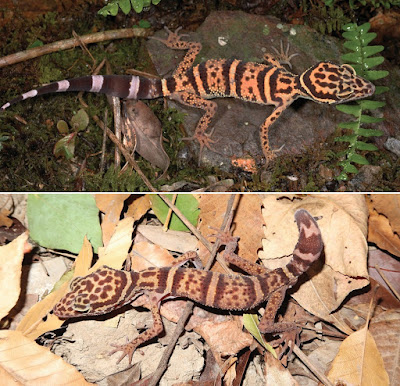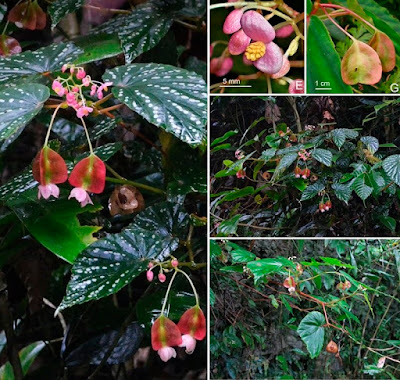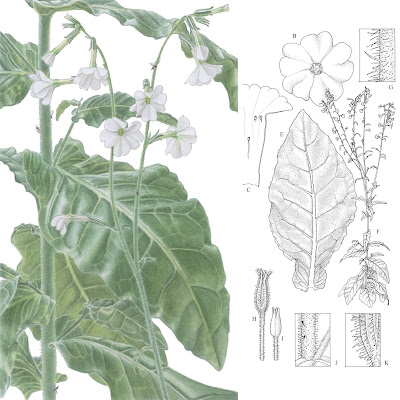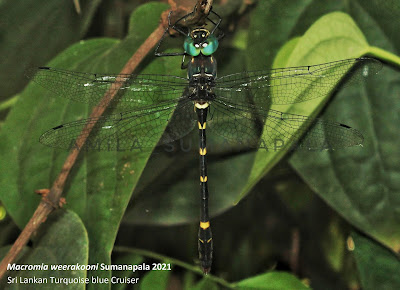[Most Recent Entries] [Calendar View]
Thursday, August 12th, 2021
| Time | Event | ||||
| 7:33a | [Herpetology • 2021] Goniurosaurus chengzheng • A New Species of Leopard Gecko (Squamata: Eublepharidae) from Guangxi, China Abstract Six species of geckos in the genus Goniurosaurus have been recorded from Guangxi, China. Here we describe a new species, Goniurosaurus chengzheng sp. nov. The new species is similar to allied species from Guangxi, but unique in a combination of the following characters: (1) four body bands with three between limb insertions; (2) precloacal pores 20; (3) body color reddish- brown; (4) snout to eye distance: eye to ear distance < 1. We used the mitochondrial genes 16S and cytb to confirm the distinctiveness of the species and place it within a molecular phylogeny of Goniurosaurus. The type specimens are deposited in the Museum of Biology, East China Normal University (ECNU). Key words: gecko, taxonomy, molecular phylogeny, karst, Guangxi, China Goniurosaurus chengzheng Zhu, Li & He sp. nov. Diagnosis. Goniurosaurus chengzheng sp. nov. differs from other congeners by a combination of the following characters: SE shorter than EE (Table 3); one nuchal loop, four body bands; number of precloacal pores 20; body color reddish brown in life (Table 4). Distribution and Life History. Goniurosaurus chengzheng sp. nov. is only known from central Guangxi, China at 100-250 m elevation. The known distributions of G. chengzheng sp. nov. and G. gezhi are not overlapping and are separated by the Zuo River. Specimens of the new species were found on limestone and soil slopes near a swallet at night. Goniurosaurus chengzheng sp. nov. was found to co-occur with Moellendorf’s Rat Snake (Elaphe moellendorffi Boettger) and a terrestrial crab (Tiwaripotamon sp.) in the limestone area. Etymology. The specific epithet chengzheng is from the Chinese phonetic alphabet 诚正, which was noted in the ancient work of Chinese literature Daxue around 2000 years ago. It means having true ideas to put one’s mind in a proper and well-ordered condition. The word chengzheng is often used in parallel with gezhi. Given this new species is sister to G. gezhi in our molecular phylogeny, we use chengzheng for the specific epithet. For the common name, we suggest “Chengzheng Cave Gecko, 诚正睑虎”. Xiao-Yu Zhu, Yi-Jiao Liu, Yun Bai, Cristian Román-Palacios, Zheng Li and Zhu-Qing He. 2021. Goniurosaurus chengzheng sp. nov., A New Species of Leopard Gecko from Guangxi, China (Squamata: Eublepharidae). Zootaxa. 4996(3); 540-554. DOI: 10.11646/zootaxa.4996.3.8 Xiao-Yu Zhu, Guang-Yu Chen, Cristian Román-Palacios, Zheng Li and Zhu-Qing He. 2020. Goniurosaurus gezhi sp. nov., A New Gecko Species from Guangxi, China (Squamata: Eublepharidae). Zootaxa. 4852(2); 211–222. DOI: 10.11646/zootaxa.4852.2.6  | ||||
| 8:03a | [Botany • 2021] Begonia benitotanii (Begoniaceae, section Petermannia) • A New Species Endemic to the Philippine Island of Bucas Grande
In 2011 and later in a 2018 field survey, an unknown Begonia species allied to taxa in section Petermannia was found in Bucas Grande Island. After thorough studies of the living plant, literature, and herbarium specimens we name the new species Begonia benitotanii, to honor Dr. Benito C. Tan, the internationally known Filipino muscologist. In 2011, there were two populations observed, each of about 300 individuals in a 100 m area. During recent fieldwork, one population was found decimated while the other was reduced to just about 50 individuals. The site is being converted into coconut, banana, and rice plantations. The area is not currently protected under the country’s National Integrated Protected Areas System by the Department of Environment and Natural Resources. According to the IUCN red list categories and criteria, B. benitotanii is hereby proposed to be placed under the Critically Endangered (CR) category. Rosario Rivera Rubite, Rochelle Yongque Brillantes, Danilo N. Tandang, Cecilia B. Moran, Mark Gregory Q. Rule and Chei-Wei Lin. 2021. Begonia benitotanii (section Petermannia, Begoniaceae) A New Species Endemic to the Philippine Island of Bucas Grande. Phytotaxa. 513(3); 257-264. DOI: 10.11646/phytotaxa.513.3.5 | ||||
| 8:24a | [Botany • 2021] Nicotiana insecticida (Solanaceae) • A New Species from Western Australia
Summary The new species Nicotiana insecticida, which is remarkable in its insect trapping abilities, is described here. It is illustrated from plants that were grown from seeds collected near the Minilya Roadhouse on the Northwest Coastal Highway in Western Australia, Australia. They were cultivated at the Royal Botanic Gardens, Kew. Its distinguishing features, taxonomy, ecology, cytology and cultivation are discussed. Nicotiana insecticida M.W.Chase & Christenh., spec. nov. Etymology: From the Latin for insect killer, a reference to this species killing numerous small insects with its extremely sticky hairs covering all parts of these plants. Mark W. Chase and Maarten J. M. Christenhusz. 2021. 994. NICOTIANA INSECTICIDA: Solanaceae. Curtis's Botanical Magazine. DOI: 10.1111/curt.12402 Illustrations by Deborah Lambkin newscientist.com/article/2286616-insect-k | ||||
| 9:52a | [Entomology • 2021] Macromia weerakooni • A New Dragonfly Species (Odonata: Anisoptera: Macromiidae) from Sri Lanka The genus Macromia is represented in Sri Lanka by two endemic species. In this paper a third presumed endemic species is described based on a single male specimen collected at Kirikitta, Weliweriya, Western Province in the low country wet zone of the country. Macromia weerakooni sp. nov. differs from its congeners in Sri Lanka by having turquoise blue eyes, an entirely black labrum, a short yellow ante-humeral stripe, an interrupted yellow stripe on the anterior margin of metepisternum anddifferences in the secondary genitalia and anal appendages. As this is the only record of the species knowledge of its natural history and distribution is limited. This discovery highlights the need for further systematic surveys of Odonata in Sri Lanka using sampling methods suitable for the detection of elusive species. Keywords: new species; endemic; South Asia
Genus Macromia Rambur, 1842 Macromia weerakooni sp. nov. Differential diagnosis: A large, black Macromia marked with yellow, with turquoise blue eyes and a turquoise blue sheen on metalic green thorax. It can be distinguished from the two other known species of Macromia in Sri Lanka by having (1) turquoise blue eyes in adults (vs. bottle green), (2) entirely black labrum (vs. labrum with yellow markings), (3) a short citron yellow triangular antehumeral stripe that reaches less than half of the length of mid-dorsal carina (vs. long antehumeral stripe in M. zeylanica and no antehumeral stripe in M. flinti), (4) an interrupted citron yellow stripe in the anterior margin of metepisternum (vs. continuous stripe in M. zeylanica and M. flinti), (5) an upward pointed, laterally flattened short spine with a broad base on the dorsal carina of last abdominal segment (vs. a broad based slightly lower and less pointed short spine in M. zeylanica and a thin, long, backward pointed spine in M. flinti), (6) cerci having a gently outward curved pointed apex (vs. an inward curved, blunt apex in M. zeylanica and an outward curved, thin, elongated and pointed apex in M. flinti), (7) Almost entirely black tergum between the roots of the wings except for a small yellow spot between forewings (vs. prominent yellow markings across tergum in both M. zeylanica and M. flinti) and (8) differently shaped secondary genitalia. Macromia weerakooni sp. nov. is clearly distinguishable from its congeners of the genus Macromia in the Western Ghats region, India other than Macromia flavicincta Selys, 1874; Macromia irata Fraser, 1924 and Macromia bellicosa Fraser, 1924 based on the structure of the secondary genitalia. It can be distinguished from the latter three species by (1) comparatively less tapering (vs. more tapering) apex of cerci, (2) shape of the dorsal spine on S10, (3) predominantly black face with some citron yellow markings (vs. predominatly citron yellow face with less black), (4) interrupted citron yellow stripe in in the anterior margin of metepisternum (vs. continuous stripe). Etymology: The specific epithet is a latinized genitive singular of Weerakoon, honouring Prof. Devaka K. Weerakoon (University of Colombo, Sri Lanka). He is an inspirational figure behind numerous biologists in the country and an academic spearheading the science based conservation activities in Sri Lanka. The author wishes to express his sincere gratitude to Prof. Weerakoon for all the guidance, support and encouragement generously provided throughout his career.
Amila Prasanna Sumanapala. 2021. Macromia weerakooni sp. nov. (Odonata: Anisoptera: Macromiidae), A New Dragonfly Species from Sri Lanka. International Journal of Odonatology. 24; 169–177. |
| << Previous Day |
2021/08/12 [Calendar] |
Next Day >> |























